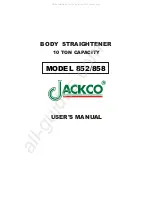
OPT-4 SPEAKER CONTROL
Your OPT-4 Speaker Selector-Volume Control is designed to operate with up to 4 pairs of
loudspeakers of 4, 8, and 16 Ohms impedance in any combination. It can be used with one or two stereo
amplifiers, or with 4 Channels of a surround-sound type sound system. Each of the 4 output control
channels can be individually switched to the amplifier connected to A AMPLIFIER INPUT, or one
connected to the B INPUT (if any). Thus it is convenient to listen to dif ferent program material in different
rooms, swap front and rear channels in a surround-sound system, etc.
Impedance loading protection for the power amplifier (s) is built-in, and fully automatic. Four 72 Watt
OPTIMATCH (tm) attenuators are employed, pre-set so that the worst-case operating condition (four
pairs of 4 Ohm speakers operating simultaneously at maximum volume) will appear as a 4 Ohm load on
the amplifier. Higher impedance speakers and/or lower volume settings of the controls will reflect a higher
impedance to the amplifier, so that cool, safe operation is assured.
Since impedance matching protection is achieved by use of OPTIMATCH (tm) transformers, there is
no heat generated in the matching process- this assures safe operation in a closed environment. There are
no extra buttons to operate that must be remembered to maintain safe operation. An additional advantage
is that there is no power loss in the OPT-4. There is a level drop of -6 dB to the speakers at maximum
volume settings of the OPT-4 controls (at the factory setting), but this is not a power loss. When all 4
controls are set at maximum volume, the full power of the source amplifier is available, divided equally
among each of the 4 speaker pairs.
Both the A and B amplifier inputs are identical, and completely independent of each other . Speakers
selected for operation with the A amplifier input will have the same impedance protection as those that
may be operating with the B amplifier. The number of pairs of speakers in operation on either channel will
have no effect on any operating on the other.
Other Opt-4 features include power handling capability of up to 72 Watts RMS continuous (216 Watts
audio) at 8 Ohms in any switching mode. The LEFT and RIGHT channels are completely separate to
assure safe operation with all types of amplifiers, including those with "bridging" outputs.
The volume attenuators are tapped auto-transformer type with attenuation of 3 dB/step except for the
last 2, which are 4 and 6 dB. These controls do not heat up in operation, nor do they deteriorate over long
time use.
Connections to amplifiers and speakers are illustrated in the back of these instructions. Remember that
the LEFT and RIGHT circuits are separate, so connections must be made correctly or the system will not
operate properly.
Heavy duty push-to-open connections are provided on the rear panel to insure positive, long lasting
connections. These connections can be used with up to 3/16" diameter. To make connections, strip about
3/8" of insulation from the wire end. Push the connector tab toward the rear panel to open the hole. Insert
the stripped wire end into the opening , and release the tab. Make sure no loose ends stick out to cause
problems. Check that the bare wire is connected to the hole, not the insulation.
If only one amplifier is to be used, connect it to the AMPLIFIER "A" terminals as shown. Make sure
the + and -, and L and R channel connections are correct to avoid unsatisfactory operation or dead
channels.
The same precautions should be used when connecting the speakers, crossed channels, polarity , or
grounds will result in improper operation.
OPERATION:
Push all ON-OFF switches that will be used in to ON. Initially, best results will probably be obtained
with all AMPLIFIER A-B switches, out at A. Set the volume control for what is likely to be the loudest
location at maximum (fully clockwise), and the rest about halfway down. Turn the HI-FI system on, and
adjust it's volume for normal listening level at the loudest location. Then adjust the volume for the
remaining locations to a satisfactory loudness. If necessary, the same procedure can be repeated for the B
AMPLIFIER channel (if any).
TECHNOLOGY
INSTALLATION MANUAL
1999 - 4/29/99




















